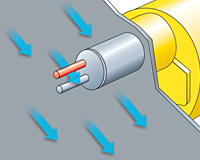

While some gases are pure, such as nitrogen or argon, others, such as biogas, consist of a mixture of gases. In addition, any change in the composition of the gas will generate incorrect results. It is essential to calibrate the meter with the gas that the end user will use since each gas has different thermal properties. This information must be transmitted to the manufacturer for optimal calibration. Points to consider: 1.- Size of the pipelineĬheck the size of the pipe at the installation site, the thickness of the pipe and the maximum gas velocity. This process is repeated several times throughout the operating range to determine the relationship between the mass flow rate and the signal for the gas and the sensor subjected to calibration. Without doing those previous steps, inaccuracies in the flow velocity may occur.ĭuring the calibration, in the flow bank, by the manufacturer, a specific amount of gas flowing through the sensor is measured. In this way, the manufacturer can calibrate the instrument according to the application. When measuring a gas with mass flow meters by thermal dispersion, it is important that the manufacturer knows the process conditions of the application that the end user requires for that meter.
#Thermal dispersio series
This may mean that the ageing or tempering temperatures of some materials are exceeded.įig.We continue with the second part of the series of articles about our Sierra mass flow meters. One point to consider is the requirement for the coating to be cured at a temperature of 150 C (300 F). These coatings can also be used to good effect on oil pans (sumps). The requirement for smaller sidepods on a single-seat car would be gladly welcomed by the aero department!
#Thermal dispersio full
The full re-optimisation of the system would include reducing the radiator area (with attendant reduction of mass) and smaller cooling ducts. This has an aerodynamic benefit that improves lap time. The team subsequently blocked the face of the radiator so that the cooling airflow was reduced, and the previous water temperature was restored. In one case of a team using this coating, they recorded a significant water temperature decrease - 10-12 F for a water temperature of about 230F. But we can use this increased cooling capacity to the benefit of the car and to make lap-time improvements. There can be unintended consequences of lowering water temperature in an engine, especially in bespoke engines where the piston-to-cylinder clearances may be tight.

In the case of the water system, a lower temperature can mean that the engine produces more power. The net effect for a given area of cooler is that the maximum temperature in the system is lowered. In the case of the major elements of a cooling system, such as a water radiator, oil cooler or charge-temperature cooler (intercooler), there are efficiency gains to be made from having a more even distribution of cooling across the whole area of the cooler.

It is on cooling systems, however, that these thermal dispersion coatings are most often used. Many of the aluminium alloys commonly used in race engines are aged in the 130-200 C (266-392 F) temperature range, so these may also benefit from the mitigation of local areas of high surface temperature. Some tool steels and most carburised steels temper below 200 C (392 F). If we can achieve a better temperature distribution over the surface, we could avoid there being a premature failure at the hot spot.Īny steel with a low tempering temperature is an example of a material where a local hot spot could start serious damage. There are many materials used in or around a race engine that experience a significant drop in mechanical and fatigue properties with increasing temperature. In terms of the eliminating surface hot spots, there are obvious advantages with being able to do this. Their most common use is on cooling system components, although one supplier we spoke to said one of his customers found success using the coating on aluminium connecting rods, making them less prone to failure. The aim of these coatings is to eliminate surface 'hot spots' on components and thereby equalise the temperature. In the recent coatings Focus article in Race Engine Technology (Issue 47, June/July 2010), there was brief mention of thermal dispersion coatings. Categories: Archive, coatings Thermal dispersion coatings


 0 kommentar(er)
0 kommentar(er)
